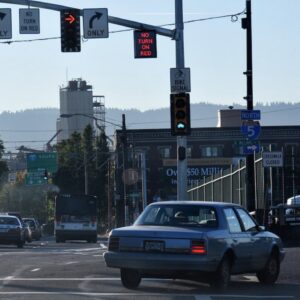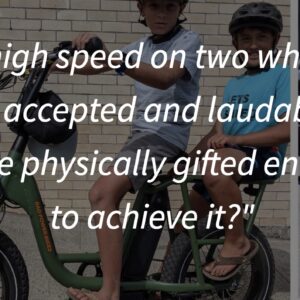Welcome to the Comment of the Week, where we highlight good comments in order to inspire more of them. You can help us choose our next one by replying with “comment of the week” to any comment you think deserves recognition. Please note: These selections are not endorsements.
Commenter ITOTS has been swinging for the bleachers all week. I had already picked a comment of theirs when they wrote another one that was even better. Given that several of you nominated it (thank you), I switched my pick at the last minute.
I liked how ITOTS stepped back from the specific, local problems at SE 26th and Powell to ask for sweeping change.
And we have yet to mention the importance of voice when it comes to quality comments. I don’t even quite know how to define it, but I know it’s there when I actually hear a voice speaking, with a timbre, tempo and range as I read. Try it yourself: Read ITOTS’s comment below a bit more slowly, and imagine someone talking. The speaker I hear is eloquent.
The moral clarity of the comment builds to the end where ITOTS asks for a profound change in priorities from those with power and authority.
Here is what ITOTS wrote:
It’s wonderful safety is getting so much attention—if only every death on Portland streets got the same kind of intense response, both from the powerful and the community.
The not-wonderful thing is all this energy, which only seems to come together once every few years, is being expended on fixing one spot, responding to one crash. You’ve got multiple institutions quickly working together to more holistically understand and solve the problem—to move bus lines and stops, upgrade signals, repaint intersections, adjust aprons, install new school zone signage; whether these things are effective is less material to me than that our institutions are actually factually trying, which seems rare.
And yet this spot is not even close to being the most heinous in town. And yet state, regional, and local officials are suddenly able to get money, ideas, and employees put to work addressing this location. I’m not here to bellyache about why that is (though I will if prodded), but to ask: Where is the similarly urgent response for other known dangerous spots? For other recent deaths?
It is predictable that 40-60 people will die on Portland streets in a given year. And we know today roughly where and how most of those deaths will take place.
It’s clear institutional attention and resources can be quickly refocused and the Overton window shifted when leadership wants them to be. How can this temporary attention and willingness from leadership be leveraged for more sweeping systemwide changes? What low-hanging fruit (like the School Zones and Leading Pedestrian Intervals for Powell/26th) can be plucked across Portland’s high-crash network today that might make the difference tomorrow? Let’s not wait for the next death to play another gruesome, dreadful round of whack-a-mole.
Another life needlessly lost is much too high a price to pay so an institution can learn lessons long apparent, to rebalance the equation of mobility and safety in favor of life, to shift resources whose sudden abundance brings angry tears and frustration even as it validates. We owe it to Sarah and the rest not to charge anyone else the highest of costs for the hard-headedness and -heartedness we allow to persist in our institutions and leaders.
Directors Strickler and Warner: this is the kind of “all hands on deck” response we expect henceforth. This is your highest priority. Not saving logistics companies three minutes on I-5, whose savings will not go to Oregon consumers as you will claim but to the companies’ shareholders as precedent demonstrates. Not making sure no one ever has to wait in their car more than one signal cycle. Not even filling potholes.
Help us find a better balance. Help us all be safer.
ITOTS’s comment can be found under the original post. Thank you ITOTS and everyone else for commenting.







Thanks for reading.
BikePortland has served this community with independent community journalism since 2005. We rely on subscriptions from readers like you to survive. Your financial support is vital in keeping this valuable resource alive and well.
Please subscribe today to strengthen and expand our work.
This made me think that ODOT could use their $500M in new borrowing capacity to lend PBOT the money to save the 3-4 lives from outer stark that are expected to be lost while waiting for improvement $ to come in
https://bikeportland.org/2022/10/17/another-death-on-outer-se-stark-this-morning-where-a-new-traffic-signal-didnt-come-soon-enough-365498
Hi Lisa – your links to the original comment do not appear to point to the correct location.
Thnx
A curb extension is built to support pedestrians, the most vulnerable street users. A curb extension works ina few key ways: prevents cars from parking at the intersection, it provides a refuge to walk into the street t check for oncoming cars, it shortens teh crossing distances, and it reduces the turning radius so cars and trucks have to take a corner more slowly.
Why is this relevant? PBOT has been removing curb extensions to maintain high vehicle speeds and numbers. NE 7th and Tillamook is the most recent of many eamples. Thy have also been closing crosswalks all over town instead of dealing withthe root danger- dangerous motor vehicle lanes. Those are just 2 examples of many examples of the way PBOT has shifted to “bike-washing” projects: projects that claim to be bike focused, but actually reduce the safety for bikes and pedestrians.
I appreciate ITOTS commnets and agree that it is a great comment of the week, but the comment is not very pointed in calling out PBOT. I read many commenters who rail against ODOT, but hold PBOT up as a force for good. IMO, those days are over, and PBOT needs to asked to reset their goals and priorities and start taking pedestrian and cycling safety seriously. Even on Freight projects, and even if it impacts traffic speeds and traffic counts.